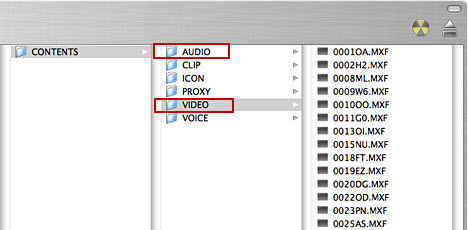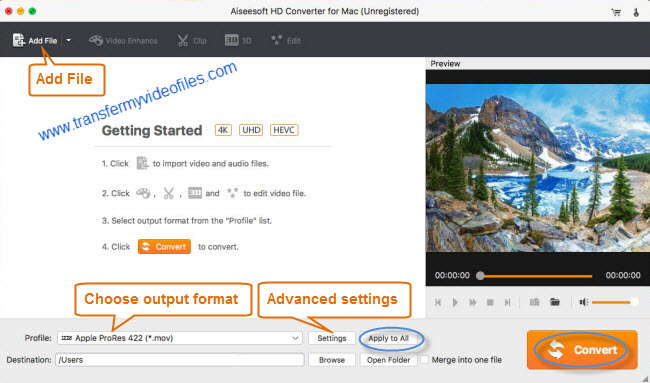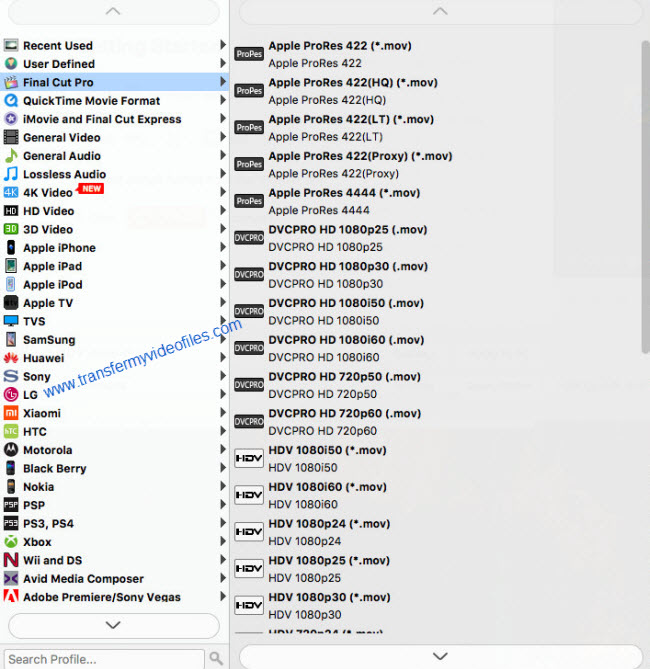Summary: Having issues while importing Panasonic AG-HPX300/370 P2 MXF footage to FCP (X) for post production? This post is to help you out. It elaborates how to convert AG-HPX300/370 P2 video to ProRes 422 format for editing in FCP version 6, 7 or FCP X smoothly preserving original quality of the .mxf file.
Need a transcoder to convert Panasonic AG-HPX370 P2 footage to ProRes for editing in FCP 7
”Hi, there, does anyone know a good P2 MXF converter for FCP? I need such a program to convert P2 MXF footage from my Panasonic AG-HPX370 to Apple ProRes format, so that I can make my Panasonic AG-HPX370 workflow with FCP 7 more smoothly and easier without waiting for a long time for rendering. Any suggestions on this? I don’t want to loose image quality while file conversion. Thanks in advance.”
If you need a converter that gives results that will closely match the original P2 .mxf file captured on a Panasonic AG-HPX370 or AG-HPX300 HD camcorder, you can give HD Video Converter for Mac a shot. It features several kinds of Apple ProRes codecs optimized for FCP (X), which maintain the highest quality and ensure optimum performance while working with FCP version 6, 7 or FCP X. Nothing could be simpler or more immediate.
Download a free trial version of HD Video Converter for Mac

Read before try
While importing Panasonic AG-HPX300/370 MXF clips to HD Video Converter for conversion, please make sure you have the entire P2 file structure as it saved on your camcorder’s P2 card. If you only have some loose .MXF clips, your files will have image only without audio. See MXF file structure on Panasonic’s P2 card as below.

MXF file structure on Panasonic’s P2 card
The above screenshot clearly shows .MXF clips are all saved in ‘VIDEO’ folder, while audio files are all stored in ‘AUDIO’ folder. When you importing .MXF clips from the correct file structure, the HD Video Converter is able to recognize audio tracks from ‘AUDIO’ folder automatically, which ensures the generated ProRes MOV files have both image and sound correctly.
Panasonic AG-HPX300/370 and FCP workflow – how to convert AG-HPX300/370 P2 MXF to ProRes 422 for FCP (X)?
The steps:
Step 1: Run Video Converter for Mac as a professional AG-HPX300/370 P2 video to ProRes Converter. When its main interface comes up, click ‘Add File’ to load source video to it.

Step 2: Select ‘Apple ProRes 422 (*.mov)’ as output format under ‘Final Cut Pro’ column. Apple ProRes 422 is the best suited editing format for using within Apple Final Cut Pro Version 6, 7, or FCP X. To create smaller files, transcode your P2 files to Apple ProRes 422 (LT).

Important: If you’ve loaded a number of video clips to do batch conversion, please do remember ticking off ‘Apply to All’ option before you start.
Step 3: Adjust video and audio settings (for advanced users)
If necessary, you can click ‘Settings’ button and go to ‘Profiles Settings’ panel to modify video and audio settings like video encoder, resolution, video bit rate, frame rate, aspect ratio, audio encoder, sample rate, audio bit rate, and audio channels. 3D settings are also available.
Step 4: Click ‘Convert’ to start Panasonic AG-HPX300/370 P2 MXF to ProRes MOV conversion.
Step 5: Click ‘Open Folder’ to get generated ProRes 422 QuickTime files for using in Final Cut Pro X/7/6 with optimum performance.
Related posts
Why Adobe Premiere Pro CS6 can’t import MXF video files?
How can I import MXF footage into Avid Media Composer?
What’s the best P2 MXF file Converter for Mac / Windows PC?
Ingest Panasonic HVX200 P2 MXF to Avid, Premiere and Vegas
Does Canon MXF/P2 MXF file not work with Sony Movie Studio?
